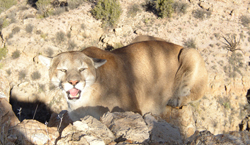 The current issue of Southwestern Naturalist has several articles that may be of interest to biologists outside of the region.
The current issue of Southwestern Naturalist has several articles that may be of interest to biologists outside of the region.
Yellow mud turtles decline in the Midwest. The largest populations of yellow mud turtles in Iowa, Illinois, and Missouri have experienced severe declines. Withdrawal of water from aquifers is the main cause, but the growth of woody plants also plays a role. Read the article, here. (Requires fee or subscription for full article.)
More info on yellow mud turtles from Texas Parks and Wildlife, here.
Cougar habitat in Texas and northern Mexico. Researchers from Sul Ross State University tested a model of current and potential cougar (Puma concolor) in Texas and northern Mexico and found that it worked. Read the article here. (Same for fees or subscription.)
Fungus strikes desert frogs. Chytrid fungus was found in desert oasis frog populations in Baja California Sur. The oases with higher infection rates also had bullfrogs and non-native crayfish. Read the article here.
Also interesting: Western red bats (Lasiurus blossevillii) and Arizona myotis (Myotis occultus) were found on the lower Arizona River after the area was restored. The Arizona myotis had been extirpated from the area, and the western red bat had not be found there previously. Read the article here.

 After three years of ticks killing off bald eagle nestlings in Arizona, the Arizona Game and Fish Department constructed “starter nests” in nearby trees. This year the bald eagle pair used one of the man-made nests and successfully fledged two young,
After three years of ticks killing off bald eagle nestlings in Arizona, the Arizona Game and Fish Department constructed “starter nests” in nearby trees. This year the bald eagle pair used one of the man-made nests and successfully fledged two young,  Oregon vesper sparrow and Mazama pocket gopher; mountain plover, burrowing owl and McCown’s longspur; the palila, a rapidly-declining Hawaiian honeycreeper; Karner blue butterfly, grasshopper sparrow, Henslow’s sparrow, and northern harrier; and white-tailed, Gunnison’s, Utah, and black-tailed prairie dogs are among the non-game species to benefit from this round of the
Oregon vesper sparrow and Mazama pocket gopher; mountain plover, burrowing owl and McCown’s longspur; the palila, a rapidly-declining Hawaiian honeycreeper; Karner blue butterfly, grasshopper sparrow, Henslow’s sparrow, and northern harrier; and white-tailed, Gunnison’s, Utah, and black-tailed prairie dogs are among the non-game species to benefit from this round of the 



